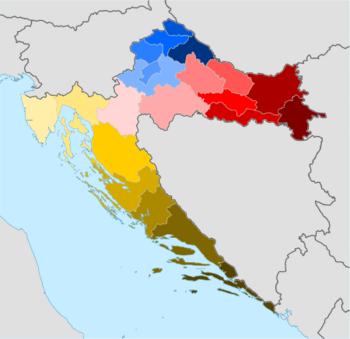
Back Condaus de Croacia AN قائمة مقاطعات كرواتيا Arabic Winkeem ke Xrvatska AVK Жупании в Хърватия Bulgarian Županije u Hrvatskoj BS Županija Catalan Chorvatské župy Czech Kroatiens distrikter Danish Επαρχίες της Κροατίας Greek Provincoj de Kroatio Esperanto
| Counties of Croatia | |
|---|---|
| |
 | |
| Category | Unitary state |
| Location | Republic of Croatia |
| Number | 20 counties plus the City of Zagreb |
| Populations | 50,927 (Lika-Senj) – 790,017 (Zagreb) |
| Areas | 640 km2 (247 sq mi) (Zagreb) – 5,350 km2 (2,067 sq mi) (Lika-Senj) |
| Government | |
| Subdivisions |
|
 |
|---|
The counties of Croatia (Croatian: hrvatske županije) are the first-level administrative subdivisions of the Republic of Croatia.[1] Since they were re-established in 1992, Croatia has been divided into 20 counties and the capital city of Zagreb, which has the authority and legal status of both a county and a city (separate from the surrounding Zagreb County).[2][3] As of 2015, the counties are subdivided into 128 cities and 428 (mostly rural) municipalities.[4][5] The divisions have changed over time since the medieval Croatian state. They reflected territorial losses and expansions; changes in the political status of Dalmatia, Dubrovnik and Istria; and political circumstances, including the personal union and subsequent development of relations between the Kingdom of Croatia-Slavonia and the Kingdom of Hungary.[6]